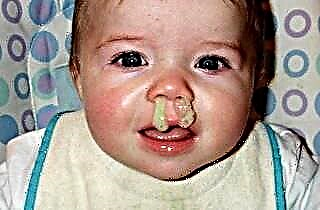Benign growths on the nasal mucosa are the most common complication of chronic rhinitis. According to statistics, they are faced with from 2 to 4% of the total population of the planet. This problem may not have any symptoms for a long time, therefore it is quite difficult to diagnose it. However, in the last stages, the symptoms of nasal polyps are quite pronounced, most often it is possible to get rid of them only with the help of surgical intervention.
Why tumors form
 Science has not yet found a definite cause for the appearance of benign neoplasms, but it knows the mechanism of the growth of polyps. When pathogenic organisms often multiply in the upper respiratory tract, the mucous membrane reacts to them with a runny nose, so it removes the pathogenic microflora from the body and protects it from infection.
Science has not yet found a definite cause for the appearance of benign neoplasms, but it knows the mechanism of the growth of polyps. When pathogenic organisms often multiply in the upper respiratory tract, the mucous membrane reacts to them with a runny nose, so it removes the pathogenic microflora from the body and protects it from infection.
However, if you do not treat a cold or constantly contact with allergens that cause hypersecretion of the mucous membrane, it will begin to deplete. In order to perform their functions, cells turn on their natural defenses, they begin to grow. The replacement tissue is the nasal polyps. They can have different shapes and sizes from a few millimeters to 4 cm. According to the location, it is customary to divide neoplasms into:
- Emoidal - most often found in adult patients, a characteristic feature of these tumors is that they are based on the ethmoid nasal mucosa and affect two sides of it at once.
- Antrochoanal - found mainly in children, located on the maxillary sinuses and most often only on one side.
- Choanal polyps are the rarest species, in terms of their location they are similar to anthrochoanal polyps, but its peculiarity lies in the fact that the cause of development is a retinal cyst.
Features of neoplasms
Symptoms of polyps in the nose can be very different, but when they first appear, the patient may not feel anything at all. This is due to the structural features of the neoplasms. In the early stages, they are rather small and invisible to the naked eye, especially if they grow in the paranasal sinuses. These are small, painless outgrowths. They are soft to the touch, like a jelly, can easily move, do not bleed and do not cause any discomfort to the patient at the beginning of the development of the disorder.
However, later, nasal polyposis acquires unpleasant symptoms. Despite the fact that the tumors remain numb, they can bleed, especially if the size is quite large.
Purulent and bloody nasal discharge is also a clear sign of an ailment, they disturb the patient constantly, no nasal sprays and drops help. People who are prone to the appearance of polyps should be especially vigilant about their well-being, this category includes patients with such diseases:
 bronchial asthma;
bronchial asthma;- regular infectious diseases;
- chronic inflammatory processes in the paranasal sinuses (sinusitis, frontal sinusitis);
- deviated septum of the nose;
- allergy;
- fungal sinusitis;
- cystic fibrosis;
- personal intolerance to alcohol and aspirin;
- muscovidosis is a complex genetic disease;
- chronic rhinitis;
- Young or Churg-Strauss syndrome.
Signs of the disease
Nasal polyps begin to disturb the patient from the very beginning of the development of the disorder, but we do not even think about how to determine their presence. The reason for this phenomenon is a good disguise of the disease, it can look like a common cold.
Constant nasal congestion does not particularly bother the patient, he uses vasoconstrictor drops and even at first feels some relief. A mild but persistent runny nose is the first symptom of the disease.
There are also other signs of nasal polyps, which we will look at in more detail.
 Breathing disorder. Polyp causes a persistent runny nose, due to nasal congestion, a person is forced to breathe through the mouth. This is very dangerous, as dry and untreated air enters the lungs. The allergens present in it can aggravate the patient's condition, insufficient moisture leads to drying out of the mucous membranes of the bronchi, which causes a painful dry cough.
Breathing disorder. Polyp causes a persistent runny nose, due to nasal congestion, a person is forced to breathe through the mouth. This is very dangerous, as dry and untreated air enters the lungs. The allergens present in it can aggravate the patient's condition, insufficient moisture leads to drying out of the mucous membranes of the bronchi, which causes a painful dry cough.- Anosmia - loss of smell. It can be complete or partial when nasal polyps develop. This is due to the fact that in the neoplasm, the work of receptors that perceive odors is disrupted. It is sometimes difficult to restore the previous sensitivity even after a special operation.
- Sneezing. This is a natural defense of the body, which turns on when foreign bodies enter the upper respiratory tract. A large polyp can irritate the cilia of the mucous membrane, she perceives it as a foreign body, and tries to remove it from the body by sneezing.
- Discharge from the nose. A runny nose at the first stage of polyposis is no different from a cold, except that it worries the patient all the time. Later, an admixture of pus and even blood appears in the mucus, which indicates the addition of secondary infections, which will be difficult to treat.
- Headache. Large neoplasms can compress nerve endings, leading to persistent headaches. Also, this symptom can cause oxygen starvation, since the cells of the body cannot normally receive air through the nose.
- Pain around the eyes. This symptom is especially often manifested in anthrochoanal polyps. Since the tumors are located in the paranasal sinuses, they can put pressure on the eyes, especially pronounced discomfort when pressing on the skin. With an advanced disease, there may even be difficulty in moving the eyelids.
- Sensation of a foreign body. The patient may feel a large polyp if it comes into contact with healthy areas of the mucosa. This is somewhat reminiscent of the presence of dried mucus in the nose, but mechanical cleaning does not provide any relief.
- Loss of taste. An overgrown neoplasm can affect not only the sense of smell, but also the taste buds. This is due to dysfunction of receptors in the hypertrophied mucous tissue.
- Hearing problems. A large polyp can partially or completely cover the entrance that leads from the nasopharynx to the auditory tube. This leads to hearing loss or complete hearing loss.
- Speech problems. In young children, polyps can cause speech impairment. If the disease is found in an adult, then a nasal tone appears in the voice, the patient constantly speaks "in the nose."
 Snore. During sleep, the polyp can partially or completely block the nasal passage, which causes the appearance of characteristic sounds when inhaling and exhaling. In some cases, even a short-term cessation of the patient's breathing during sleep is possible (sleep apnea).
Snore. During sleep, the polyp can partially or completely block the nasal passage, which causes the appearance of characteristic sounds when inhaling and exhaling. In some cases, even a short-term cessation of the patient's breathing during sleep is possible (sleep apnea).- Permanently open lower jaw. As the polyp gets larger, it not only makes it difficult, but makes it impossible to breathe through the nose. This leads to the fact that a person is forced to breathe through his mouth, because his lower jaw constantly drops.
- Changes in the facial skull and dentition. Most often, these serious symptoms occur in children, as their bones are still forming. A constantly open mouth leads to the fact that the nasolabial fold is smoothed out, the bite is disturbed, and sometimes even an abnormal development of the chest is observed.
- Fast fatiguability. In the presence of a polyp, breathing is disturbed and, as a result, the supply of oxygen to all cells.This leads to insufficient working capacity of the brain and muscles, a person cannot normally engage in either mental or physical activity.
- Disorders of appetite and digestion. Appetite disappears due to the lack of taste and smell, as well as from chronic fatigue. Digestive upset is observed most often when secondary infections are attached, because pathogenic microbes can penetrate the digestive tract.
Where to go
As soon as you find at least one of the symptoms, immediately go to an appointment with an otolaryngologist. This is a specialist who diagnoses and treats all diseases of the ear, nose and throat. With the help of endoscopy and rhinoscopy, the patient is examined, these methods allow you to visually assess the picture.
Also, the doctor will prescribe additional tests, it can be allergy tests, a blood test, a test for cystic fibrosis (a genetic predisposition to the appearance of cysts).
The hardware methods for identifying the problem include magnetic resonance imaging and computed tomography, as well as radiology. These diagnostic measures help the doctor know the size, number, and location of neoplasms, even if they cannot be seen with an external examination.
After evaluating all the factors and studying the clinical picture, the ENT chooses a method to eliminate the problem.
Forecasts
 Depending on which method of treatment the doctor chooses, and on the characteristics of the patient's body, polyps can disappear forever or for a long time. Most often, relapses of the violation occur. It can be caused by individual predisposition and misdiagnosis.
Depending on which method of treatment the doctor chooses, and on the characteristics of the patient's body, polyps can disappear forever or for a long time. Most often, relapses of the violation occur. It can be caused by individual predisposition and misdiagnosis.
If the therapy was aimed not only at eliminating neoplasms, but also at treating the diseases that led to their appearance, then the risk of re-emergence of tumors is minimal.
To consolidate the results obtained from the treatment, doctors recommend that patients take a course of homeopathic medicines or use folk remedies to prevent the reoccurrence of the disorder. Also, the patient must completely protect himself from diseases that can cause an overgrowth of the mucous membrane. To do this, you should follow these rules:
- maintain local immunity, walk more often in the fresh air;
- vitaminize the diet;
- eat more cereals, legumes, cereals;
- take products that are beneficial to the immune system, such as honey, milk, etc.;
- avoid hypothermia, always dress well in the cold season;
- do not visit crowded places during epidemics;
- not to contact patients, so as not to get infected yourself;
- protect yourself from the negative effects of allergens;
- to refuse from bad habits;
- have a good rest;
- go in for sports, it hardens the body well.
Possible complications
If you do not adhere to all these rules and do not go to the ENT for preventive examinations on time, polyps can give serious complications. This is the acquisition of new concomitant diseases, and the addition of severe infections, and other disorders, up to and including death.
Untimely treatment of neoplasms can lead to the following consequences:
- pharyngitis;
- laryngitis;
 tracheitis;
tracheitis;- laryngotracheitis;
- bronchitis;
- pneumonia;
- sinusitis;
- inflammation of the adenoids;
- angina;
- chronic tonsillitis;
- otitis;
- eustachitis;
- increased risk of stroke due to the formation of blood clots in the veins;
- meningitis (infection of the membranes and fluids surrounding the spinal cord and brain).
Let's summarize
It is quite difficult to recognize the presence of polyps in the nose in the early stages, but it is quite possible if you follow the changes in the body well. If you find any signs of the disease, you need to go to the doctor and undergo a course of treatment, otherwise very serious complications may appear.
Undergo preventive examinations in the ENT office on time and do not ignore medical care in case of diseases, this will help maintain health.

 bronchial asthma;
bronchial asthma; Breathing disorder. Polyp causes a persistent runny nose, due to nasal congestion, a person is forced to breathe through the mouth. This is very dangerous, as dry and untreated air enters the lungs. The allergens present in it can aggravate the patient's condition, insufficient moisture leads to drying out of the mucous membranes of the bronchi, which causes a painful dry cough.
Breathing disorder. Polyp causes a persistent runny nose, due to nasal congestion, a person is forced to breathe through the mouth. This is very dangerous, as dry and untreated air enters the lungs. The allergens present in it can aggravate the patient's condition, insufficient moisture leads to drying out of the mucous membranes of the bronchi, which causes a painful dry cough. Snore. During sleep, the polyp can partially or completely block the nasal passage, which causes the appearance of characteristic sounds when inhaling and exhaling. In some cases, even a short-term cessation of the patient's breathing during sleep is possible (sleep apnea).
Snore. During sleep, the polyp can partially or completely block the nasal passage, which causes the appearance of characteristic sounds when inhaling and exhaling. In some cases, even a short-term cessation of the patient's breathing during sleep is possible (sleep apnea). tracheitis;
tracheitis;

